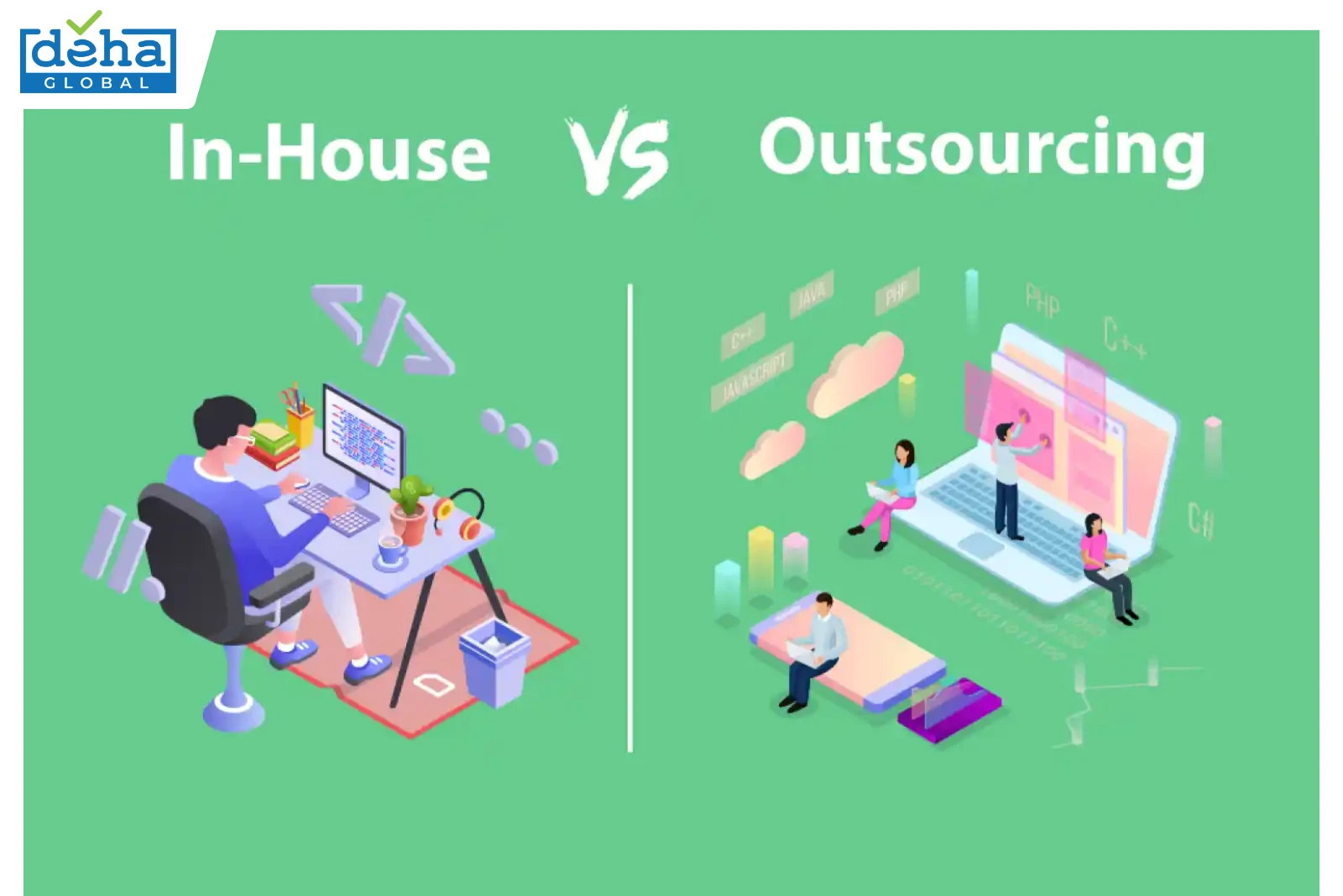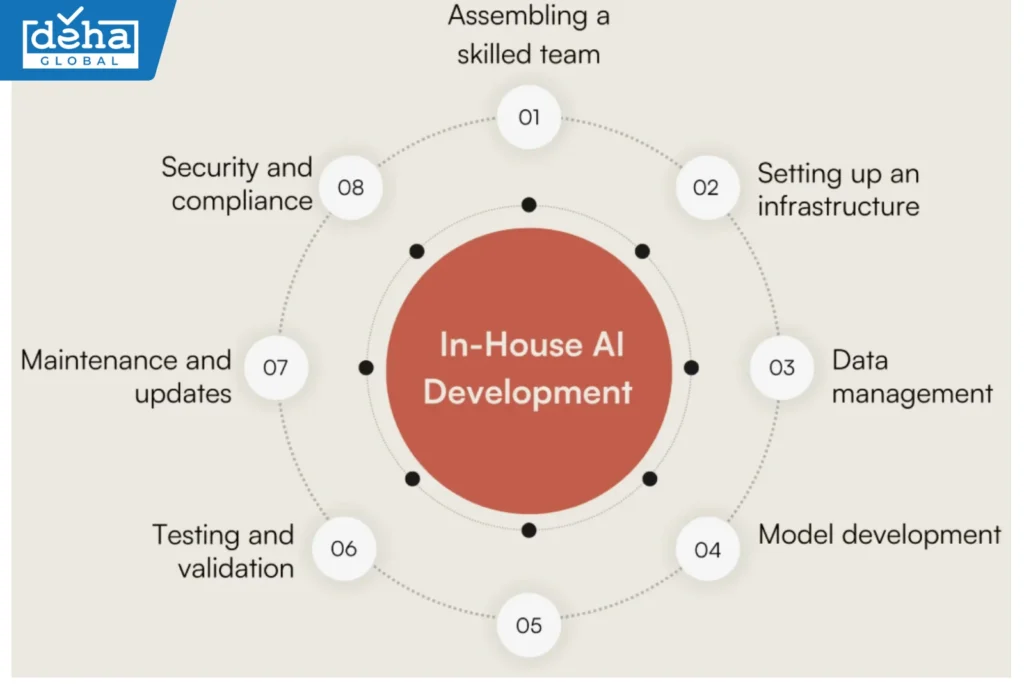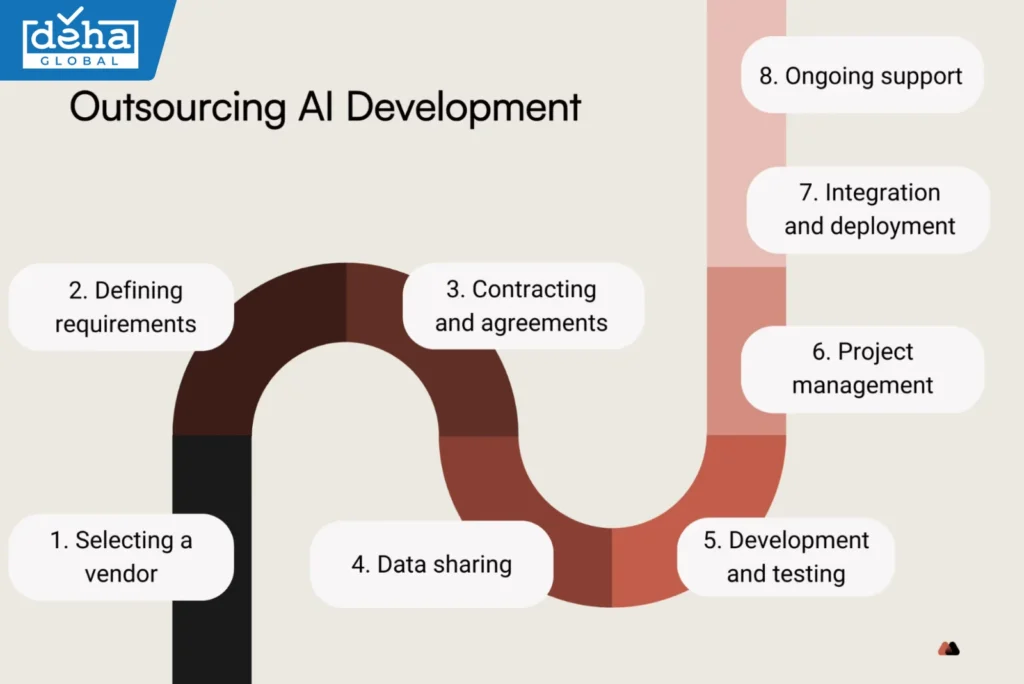Table of contents

AI is becoming a key part of how businesses grow, automate, and stay competitive. But one big decision a lot of teams face early on is whether to build AI in-house or outsource it to a specialist. This choice isn’t just about cost — it also affects how fast you can move, how much control you have, and the kind of talent you need. In this article, we’ll break down both options and compare them across cost, expertise, flexibility, control, and data security.
When a company decides to dive into AI, one of the first big questions is whether to build everything from within or look outside for help. Going the in-house route means keeping everything close — from the team to the tools — but it’s not always the easiest or cheapest path. Let’s take a closer look at what this approach really involves, and whether it’s worth the commitment.
| Task | Description |
| AI team recruitment | Hiring full-time specialists like ML engineers, data scientists, and AI leads. |
| Infrastructure setup | Investing in hardware, software, and cloud platforms needed for AI workloads. |
| Data collection and prep | Collecting, cleaning, and managing data internally. |
| AI model development | Creating, testing, and deploying models with the internal team. |
| Ongoing model maintenance | Regularly monitoring and updating models to keep them accurate and efficient. |
| Internal coordination | Ensuring strong collaboration between tech and business teams. |

Building AI solutions in-house is a serious commitment — not just in terms of money, but also time, people, and long-term strategy. You’re essentially setting up an entire AI team under your roof, and that means hiring folks with very specific skills: data scientists, machine learning engineers, DevOps engineers, AI product managers, and probably some software developers too. It’s not like hiring one or two people and calling it a day — this usually involves a full-blown recruitment drive.
Then there’s the infrastructure. AI development isn’t something you can do on a standard laptop. You need servers, cloud storage, GPUs for training models, and platforms for handling data pipelines and model deployment. That setup alone can take weeks — sometimes months — depending on your resources.
Another big piece of the puzzle is data. You’ve got to collect it, clean it, label it, and keep it organized. This part is often overlooked, but it eats up a lot of time and effort. Plus, once your models are trained, they’ll need continuous updates. AI systems aren’t a one-and-done thing — they evolve, and someone has to keep them in shape.
Also, leadership matters. If no one on the management side understands AI, or if the company isn’t fully bought into the idea, progress can stall fast. You need clear goals, a product roadmap, and consistent communication between tech teams and business teams to keep everyone aligned.
Not every business has the time, money, or headcount to build an AI team from scratch — and honestly, that’s completely fair. Sometimes, it makes way more sense to hand over the work to a team that’s already been doing it for years. That’s where outsourcing comes in, and it’s become a solid option for companies that want results fast without all the internal setup.
| Task | Description |
| External partner engagement | Selecting and onboarding an experienced AI development agency. |
| Project scoping and planning | Setting clear goals, requirements, and deliverables. |
| End-to-end AI delivery | Partner handles the full AI development lifecycle. |
| Communication and updates | Regular meetings to ensure alignment and address changes. |
| Security and compliance | Protecting sensitive data through contracts and security measures. |
| Documentation transfer | Receiving technical documentation and system handover for future use. |

Outsourcing AI development usually means partnering with a third-party company that specializes in this space. These are teams that live and breathe AI — they’ve already got the people, the tools, and the experience to jump in and start building right away. Instead of spending months assembling your own crew, you simply bring in the experts and let them handle it.
The process usually starts with defining what you need: the business goals, what kind of data you have, and what kind of outcomes you’re aiming for. From there, the AI partner will put together a development plan. They’ll handle everything from model design and training to testing and deployment. You’ll still need to stay involved with regular updates and decision-making, but the heavy lifting is done on their side.
Communication is key in these kinds of setups. You’ll want to make sure there are clear points of contact, shared timelines, and agreements on deliverables. Some companies worry about being left in the dark, but with the right partner, you can get full transparency and accountability.
Security and compliance are also big concerns. When you’re handing over sensitive data, you have to make sure the partner follows strict privacy rules and takes data protection seriously. That usually means signing NDAs, putting clear contracts in place, and choosing a provider with a solid track record.
Choosing between in-house and outsourced AI development isn’t just about cost—it’s about control, speed, and long-term strategy. Both approaches have trade-offs, and what works for one company might be a disaster for another. Let’s break down the key differences to see which one comes out on top in each category.
In-house development requires significant upfront investment. You’ll need to hire skilled AI engineers (who command high salaries), purchase or lease computing infrastructure, and budget for ongoing training and maintenance. While this may pay off long-term, the initial AI costs can be prohibitive for many companies.
Outsourcing AI development typically operates on a more flexible cost structure. You pay for exactly what you need, whether that’s a fixed-price project or hourly consulting rates. This can be much easier on cash flow initially, though AI costs may accumulate over time through vendor fees and service charges.

Winner: Outsourcing takes this round for most businesses, as it dramatically lowers the financial barrier to entry for AI implementation.
Going the in-house route gives you complete ownership over your AI development. Every decision—from which algorithms to use to how data gets processed—rests with your team. However, this control comes at the expense of flexibility; scaling up requires hiring more staff or buying additional hardware.
When you outsource, you sacrifice some control in exchange for greater agility. Vendors can quickly allocate more resources or specialists as needed, allowing you to scale up or down without the headaches of recruitment or infrastructure management.
Winner: It’s a tie—in-house wins for control, outsourcing for flexibility. Your choice depends on which factor matters more for your specific needs.
Building an in-house team means your AI capabilities are only as strong as your hiring process. You’ll need to attract and retain top talent while ensuring they stay current with rapidly evolving AI advancements—a challenging and expensive proposition.
Outsourcing partners bring immediate access to specialized knowledge and cutting-edge techniques. Reputable firms invest heavily in staying ahead of the curve, giving you instant expertise without the recruitment struggle.

Winner: Outsourcing clearly wins here, providing superior expertise without the HR headaches—unless you’re a tech giant that can afford world-class AI talent.
In-house development moves slowly. Between assembling a team, setting up infrastructure, and the actual development process, you’re looking at months (if not years) before seeing results. This timeline can be disastrous in fast-moving industries.
Outsourced solutions offer dramatically faster deployment. Experienced vendors have pre-built frameworks and teams ready to go, potentially delivering working prototypes in weeks rather than months.
Winner: Outsourcing is the undisputed champion when speed matters.
Keeping development in-house provides maximum security for sensitive data. You maintain complete oversight of where information is stored, how it’s processed, and who accesses it—crucial for industries like healthcare or finance.
Outsourcing requires placing trust in third-party vendors. While contracts and audits can mitigate risks, you’re ultimately relying on another company’s security protocols and integrity.
Winner: In-house development takes this category, especially for organizations handling highly confidential data.
There’s no universal “right” choice—it depends entirely on your company’s priorities, resources, and risk tolerance. Many successful businesses actually blend both approaches: outsourcing initial development to prove concepts quickly, then bringing successful models in-house for long-term control.
From what I’ve observed, the smartest strategy is to outsource your first AI projects to validate their value, then consider building internal capabilities once you’ve established a clear ROI.
If you’re leaning towards outsourcing your AI development, DEHA Global offers a comprehensive suite of services tailored to meet diverse business needs. Their expertise spans from AI MVP development to full-scale AI solutions, leveraging advanced tools like Azure OpenAI, Azure AI Vision, and Azure AI Language to ensure scalability and efficiency. By partnering with DEHA, you can access a team of seasoned professionals who can accelerate your AI initiatives without the overhead of building an internal team from scratch.
For organizations considering in-house development, DEHA provides flexible collaboration models that can complement your internal efforts. Whether you need specialized talent to augment your team or require guidance on best practices, DEHA’s experience in AI development can bridge skill gaps and provide valuable insights. Their commitment to quality is evidenced by certifications like ISO 9001:2015 and CMMI Level 3, ensuring that their processes align with international standards.

Ultimately, DEHA’s adaptable approach allows you to choose the engagement model that best fits your strategic objectives. Whether you opt for full outsourcing or a hybrid model that combines internal and external resources, DEHA’s proven track record and comprehensive service offerings can support your AI development journey, ensuring that your solutions are both effective and aligned with your business goals.
In Conclusion
At the end of the day, there’s no one-size-fits-all answer — it really depends on your company’s goals, budget, and internal capabilities. In-house development gives you more control and long-term value but requires a lot of upfront investment. Outsourcing is faster and often more affordable, but comes with its own trade-offs in terms of control and data sensitivity. Take a good look at your resources and timeline, and choose the path that supports your business best.